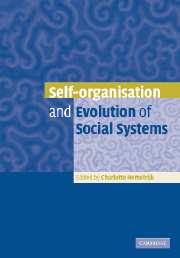Book contents
- Frontmatter
- Contents
- List of contributors
- Preface
- Introduction
- 1 From unicellular to multicellular organisation in the social amoeba Dictyostelium discoideum
- 2 Optimality of communication in self-organised social behaviour
- 3 The interplay of intracolonial genotypic variance and self-organisation of dominance hierarchies in honeybees
- 4 Traffic rules of fish schools: a review of agent-based approaches
- 5 A process-oriented approach to the social behaviour of primates
- 6 Order and noise in primate societies
- 7 Self-organisation in language
- 8 Dictatorship effect of majority rule in voting in hierarchical systems
- 9 Natural selection and complex systems: a complex interaction
- 10 Interlocking of self-organisation and evolution
- Index
- References
10 - Interlocking of self-organisation and evolution
Published online by Cambridge University Press: 07 December 2009
- Frontmatter
- Contents
- List of contributors
- Preface
- Introduction
- 1 From unicellular to multicellular organisation in the social amoeba Dictyostelium discoideum
- 2 Optimality of communication in self-organised social behaviour
- 3 The interplay of intracolonial genotypic variance and self-organisation of dominance hierarchies in honeybees
- 4 Traffic rules of fish schools: a review of agent-based approaches
- 5 A process-oriented approach to the social behaviour of primates
- 6 Order and noise in primate societies
- 7 Self-organisation in language
- 8 Dictatorship effect of majority rule in voting in hierarchical systems
- 9 Natural selection and complex systems: a complex interaction
- 10 Interlocking of self-organisation and evolution
- Index
- References
Summary
Introduction
Organisms can cope with a variable environment in which various actions are called for in a variety of ways, e.g.:
‘Red Queen’ evolution. Each individual performs the different types of actions with a pre-set frequency. There is some within-population/ species variation in these frequencies (i.e. it is a ‘quasi-species’ rather than a monomorphic species). Because many variants are present in the population, changes in the environment will cause relatively rapid change in the population by selection of available genotypes of the quasi-species. In such a case the rate of change is fairly independent of mutation rate.
Frequency-dependent selection. There are two or more subtypes in the population, each specialising on one or a subset of the actions. In contrast to the previous mode the within-population variation is not unimodal but multi-modal. Dependent on which actions are more in demand these subpopulations will increase/decrease. A clear-cut example is the distribution of the ‘rover’ and ‘sitter’ types in Drosophila, which do what the names suggest in foraging. The difference has been localized to two different alleles of a cGMP-dependent kinase gene which has plural effects, among which is a change in ion channels in the brain, ultimately leading to the two modes of exploiting food resources (Osborne et al., 1997; Sokolowski, 1997; Renger et al., 1999).
[…]
- Type
- Chapter
- Information
- Self-Organisation and Evolution of Biological and Social Systems , pp. 166 - 189Publisher: Cambridge University PressPrint publication year: 2005
References
- 1
- Cited by



